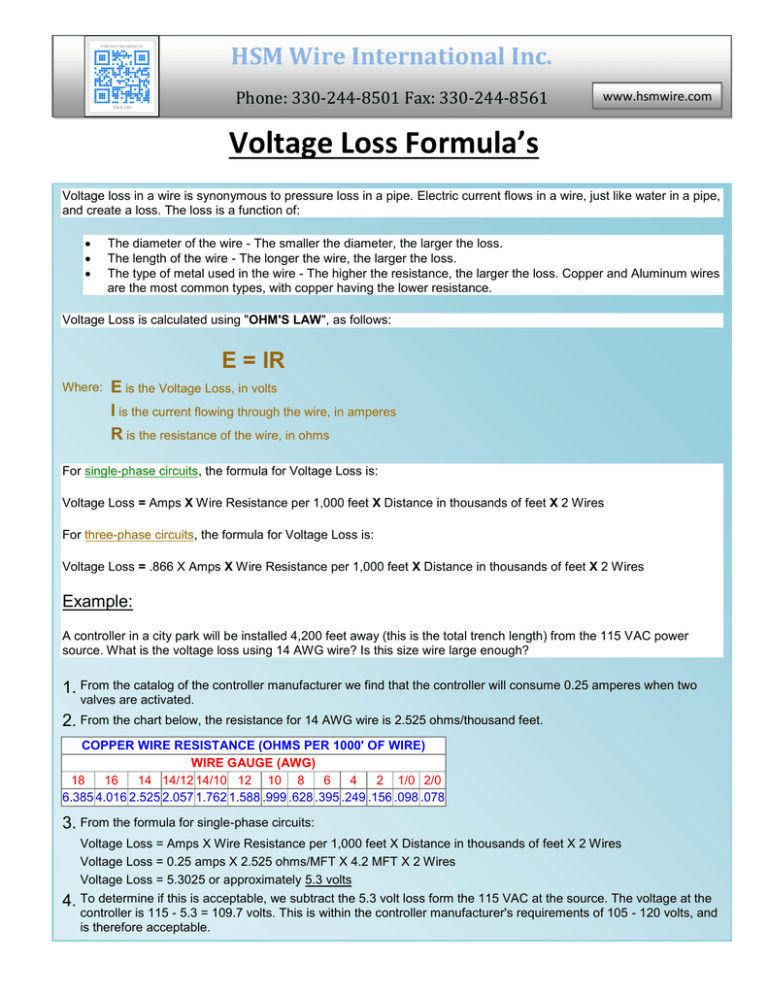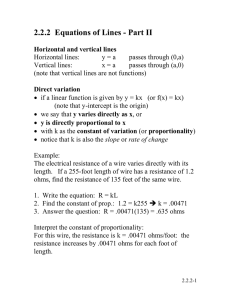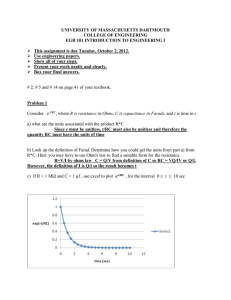
HSM Wire International Inc.
Phone: 330-244-8501 Fax: 330-244-8561
www.hsmwire.com
Voltage Loss Formula’s
Voltage loss in a wire is synonymous to pressure loss in a pipe. Electric current flows in a wire, just like water in a pipe,
and create a loss. The loss is a function of:
The diameter of the wire - The smaller the diameter, the larger the loss.
The length of the wire - The longer the wire, the larger the loss.
The type of metal used in the wire - The higher the resistance, the larger the loss. Copper and Aluminum wires
are the most common types, with copper having the lower resistance.
Voltage Loss is calculated using "OHM'S LAW", as follows:
E = IR
Where:
E is the Voltage Loss, in volts
I is the current flowing through the wire, in amperes
R is the resistance of the wire, in ohms
For single-phase circuits, the formula for Voltage Loss is:
Voltage Loss = Amps X Wire Resistance per 1,000 feet X Distance in thousands of feet X 2 Wires
For three-phase circuits, the formula for Voltage Loss is:
Voltage Loss = .866 X Amps X Wire Resistance per 1,000 feet X Distance in thousands of feet X 2 Wires
Example:
A controller in a city park will be installed 4,200 feet away (this is the total trench length) from the 115 VAC power
source. What is the voltage loss using 14 AWG wire? Is this size wire large enough?
1. From the catalog of the controller manufacturer we find that the controller will consume 0.25 amperes when two
valves are activated.
2. From the chart below, the resistance for 14 AWG wire is 2.525 ohms/thousand feet.
COPPER WIRE RESISTANCE (OHMS PER 1000' OF WIRE)
WIRE GAUGE (AWG)
18
16
14 14/12 14/10 12 10 8
6
4
2 1/0 2/0
6.385 4.016 2.525 2.057 1.762 1.588 .999 .628 .395 .249 .156 .098 .078
3. From the formula for single-phase circuits:
Voltage Loss = Amps X Wire Resistance per 1,000 feet X Distance in thousands of feet X 2 Wires
Voltage Loss = 0.25 amps X 2.525 ohms/MFT X 4.2 MFT X 2 Wires
Voltage Loss = 5.3025 or approximately 5.3 volts
4. To determine if this is acceptable, we subtract the 5.3 volt loss form the 115 VAC at the source. The voltage at the
controller is 115 - 5.3 = 109.7 volts. This is within the controller manufacturer's requirements of 105 - 120 volts, and
1
is therefore acceptable.
HSM Wire International Inc.
Phone: 330-244-8501 Fax: 330-244-8561
www.hsmwire.com
Ohm’s Law Guide
To be used as a guide only
Ohms
Ohms = Volts ÷ Amperes
Where:
Ohms = R
Volts = E
Amperes = I
Formula:
R=E÷I
Example:
E = 22.75, I = 3.5
Therefore
R = 22.75 ÷ 3.5 = 6.5 Ohms
Volts
Volts = Amperes x Ohms
Where:
Volts = E
Amperes = I
Ohms = R
2
Formula:
E=IxR
Example:
I = 3.5, R = 6.5
Therefore:
E = 3.5 x 6.5
E = 22.75
Amperes
Amperes = Volts ÷ Ohms
Where:
Amperes = I
Volts = E
Ohms = R
Formula:
I=E÷R
Example:
E = 22.75, R = 6.5
Therefore:
I = 22.75 ÷ 6.5
I = 3.5 Amperes
3
Watts
Watts = (amperes)2 x Ohms
Where:
Watts = W
Amperes = I
Ohms = R
Formula:
W = I2 x R
Example:
I = 3.5, R = 6.5
Therefore:
W = (3.5)2 x 6.5
W = 12.25 x 6.5
W = 79.625 Watts
Useful Coil Formulas
Length of one turn of wire = Pi x (Outside coil diameter – Wire diameter)
Number of turns of wire per inch of coil = 1/ (Wire diameter)
Length of wire in 1” of closed coil = [Pi x (Outside coil diameter – Wire diameter)]/
(Wire diameter)
Resistance per inch of closed coil = [Pi x (OD – Wire diameter) (Resistance /Ft. of
Wire)]/ 12 (Wire diameter)
Length of coil = [Total resistance of coil] / [Resistance per inch of closed coil]
Combining the formulas given above, we get the complete formula for coil
calculations.
4
Length of Coil =
[Coil Resistance x Wire diameter] / [.262 x (Coil OD – Wire diameter) *
(Resistance/Ft. of Wire used)]
Wire Resistance =
[(OHMS – Circular Mils) / Feet] / [Diameter in Mils Squared]
Strip and Ribbon Resistance Factor=
[OHMS/Sq.Mil Ft.] / Thickness (mils) x Width (mils) x Correction]
If calculations are done for ribbon wire, a correction factor of .94 or .83 must be used
depending on the ratio of width to thickness. The higher the width to thickness ratio
the lower the correction factor is.
Wire Weight=
[Pi x r^2 x Length x Lbs.] / Cubic Inch
Strip Weight =
[Thickness x Width x Length x Lbs.] / Cubic Inch
OHMS/Sq Mil Ft. =
OHMS/Cir.Mil Ft. x .7854
Q: How do I calculate the amperage for a given round magnet wire?
A: The formula for current carrying capacity in amperes for copper magnet wire wound into a coil is: d2 x
4869.48 (d = diameter in inches). This formula is pretty conservative, and formulas from other sources based
on straight lengths of solid or stranded conductors in ambient air may indicate greater current carrying
capacity than this one.
The American Heritage Dictionary defines ‘Ohms’ as; A unit of electrical resistance equal to that of a conductor in which a current of one
ampere is produced by a potential of one volt across its terminals. Also ‘Volts’ is defined as; The international system of electrical
potential and electromotive force, equal to the difference of electrical potential between two points on a conducting wire carrying a
constant current.
Copyright © 2013 HSM Wire International, Inc. All Rights Reserved.
REV: 4.06.28.13
5





